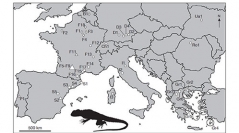

 Geodiversitas
30 (3) - Pages 641-656
Geodiversitas
30 (3) - Pages 641-656The abundant remains from the Plio-Pleistocene fissure fillings of Monte Tuttavista (Orosei, Sardinia, Italy) allow identifying an acrodont lizard with anterior pleurodont teeth belonging to the family Agamidae. The morphology of the available skeletal elements does not significantly differ from that of the extant genera Agama and Laudakia. The poor knowledge of the comparative osteology of these genera hinders a confident identification of the remains that are simply referred to Agama s.l. (including both genera). In order to evaluate the contribution offered by palaeontology to the biogeography of the European agamids, an overview of their fossil record is presented. Agamids are present in about 40 European localities. The fossil record indicates that these lizards inhabited the continent since at least the early Eocene, with an apparent hiatus during the middle and late Eocene. The geographic range reached relatively high latitudes during the Paleogene (Belgium) and Miocene (Germany and Ukraine), but since the Pliocene it was restricted to the Mediterranean regions only. The Plio-Pleistocene remains from Sardinia here described are among the youngest European evidences for the presence of these lizards outside the modern range. Curiously, there are no unambiguous Pleistocene remains even in the Balkans, the only European Mediterranean area in which agamids still live. The absence of post Pliocene remains in the Balkans could suggest that the restricted modern European range of Laudakia stellio is not the relict of a formerly larger range but that, if not of antropochorous origin, the ancestors of extant populations dispersed relatively recently from the east.
Lacertilia, Agamidae, Agama, Laudakia stellio, Uromastyx, Monte Tuttavista-Orosei, lizard biogeography, faunal dispersals, anthropochorous fauna